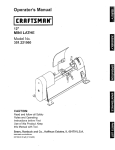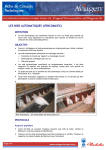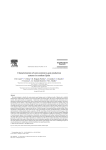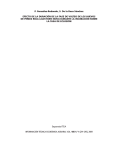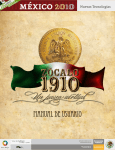Download (Alectoris rufa) game farms in Spain
Transcript
Instituto Nacional de Investigación y Tecnología Agraria y Alimentaria (INIA) Available online at www.inia.es/sjar Spanish Journal of Agricultural Research 2010 8(3), 624-633 ISSN: 1695-971-X eISSN: 2171-9292 Characterisation and typification of the red-legged partridge (Alectoris rufa) game farms in Spain P. González-Redondo1*, M. Delgado-Pertíñez1, S. Toribio1, F. A. Ruiz2, Y. Mena1, F. P. Caravaca1 and J. M. Castel1 1 Departamento de Ciencias Agroforestales. Escuela Universitaria de Ingeniería Técnica Agrícola. Universidad de Sevilla. Ctra. de Utrera, km 1. 41013 Sevilla. Spain 2 IFAPA «Camino de Purchil». Junta de Andalucía. 18080 Granada. Spain Abstract This study was aimed to characterise and typify the red-legged partridge (Alectoris rufa) game farms in Spain using variables related to structure and marketing. A structured survey was carried out on 63 farms in 2008. A multiple correspondence analysis performed to characterise the farms yielded two dimensions. First dimension explained 45.1% of the variance and included the variables age of the farm and number of pairs in the breeding flock. Second dimension explained 35.9% of the variance and included the variables the farm sells hatching eggs and the farm has a hunting preserve where releasing part of the partridges produced. A cluster analysis differentiated three farm typologies. Farm type 1 included 36 complete-cycle farms mainly established until 1996, most of them having 1 to 999 pairs in the breeding flock. Farm type 2 included 11 farms without breeding flock established since 2003. Farm type 3 included 16 complete cycle farms established between 1997 and 2002, most of them being the highest with 1,000 onwards breeding pairs, and carrying out artificial photoperiod supplementation of the breeding pairs. Half of the farms in this group sell hatching egg, have ever exported partridges, and most of them have a hunting preserve where releasing part of the production. The establishment of red-legged partridge game farms increased until 2002, declining thereafter and shifting towards the second farm type without breeding flock. This alternative poultry production system could have reached its development maturity and is a sub-sector well established in Spain, despite being only four decades old. Additional key words: advertising strategies, alternative poultry, hunting species, multivariate analysis. Resumen Caracterización y tipificación de las granjas cinegéticas de perdiz roja (Alectoris rufa) en España El objetivo de este estudio fue caracterizar y tipificar las granjas cinegéticas de perdiz roja (Alectoris rufa) en España usando variables relacionadas con su antigüedad, tamaño, estructura, comercialización y publicidad. Para ello se realizó una encuesta estructurada a 63 granjas en 2008. Un análisis de correspondencias múltiple generó dos dimensiones. La primera explicó el 45,1% de la varianza, incluyendo las variables antigüedad de la granja y número de parejas reproductoras. La segunda explicó el 35,9% de la varianza, incluyendo las variables venta de huevos incubables y tenencia de un coto de caza donde se sueltan perdices producidas por la granja. Un análisis de conglomerados subsiguiente diferenció tres tipologías de granjas. La tipología 1 incluyó 36 granjas de ciclo completo fundadas principalmente hasta 1996, mayoritariamente con plantel reproductor de hasta 999 parejas. La tipología 2 incluyó 11 granjas sin reproductores fundadas desde 2003. La tipología 3 incluyó 16 granjas de ciclo completo fundadas entre 1997 y 2002, siendo la mayoría de mayor tamaño, con al menos 1.000 parejas reproductoras, y que suplementan artificialmente el fotoperiodo a los reproductores. La mitad de las granjas de este grupo vende huevos incubables y ha exportado perdices, y la mayoría tiene un coto de caza donde sueltan perdices. La fundación de granjas de perdiz creció hasta 2002, disminuyendo después con tendencia hacia la creación de granjas de la tipología 2 sin reproductores. Se concluye que este sub-sector avícola está consolidado y ha alcanzado su madurez en España, pese a tener sólo cuatro décadas de existencia. Palabras clave adicionales: análisis multivariante, avicultura alternativa, especies cinegéticas, publicidad. * Corresponding author: [email protected] Received: 12-10-09; Accepted: 08-06-10. Abbreviations used: MCA (multiple correspondence analysis). Characterisation and typification of the red-legged partridge farms in Spain Introduction The red-legged partridge (Alectoris rufa) is a game species raised in farms in countries such as Spain, France, Portugal, England, and Italy (Office National de la Chasse, 1973; González-Redondo, 2004; Canning, 2005). In Spain its industrial breeding for hunting purpose started in the middle of Sixties after successful experiences carried out at Quintos de Mora (Toledo province) experimental centre (Lara and Arenzana, 1965). These experiences led to the development of a game farms sector that quickly rose (Flores, 1979; González-Redondo, 2004). The original model followed by most of these farms is the complete-cycle, aimed at raising partridges for release and restocking of hunting areas (Pérez y Pérez, 1981; González-Redondo, 1999, 2004). Breeding partridges, with ages usually ranging from one to three years old, are kept in pairs in outdoor cages (Flores, 1979; Pérez y Pérez, 1981; González-Redondo, 2004). A breeding red-legged partridge lays an average of 30 eggs per reproductive season, running usually from March to July (Pérez y Pérez, 1981; González-Redondo et al., 2003). However, the red-legged partridge reproductive performance varies greatly due to its remarkable reproductive seasonality, this being more intense under a natural photoperiod (Pérez y Pérez, 1981; González-Redondo et al., 2003) than under artificial photoperiod supplementation (Pérez y Pérez, 1981; Bagliacca et al., 1988; González-Redondo, 2006b). The eggs are collected on a daily basis and are stored before being loaded in an artificial incubator, where are incubated at 37.8°C and 55% relative humidity until the hatching occurs after a 23 to 24-day incubation period (Flores, 1979; Pérez y Pérez, 1981; González-Redondo, 2006b; GonzálezRedondo and De la Rosa, 2009). The newly hatched chicks are reared during a four to six weeks period in brooder houses where a litter on the floor, fresh water and starter mash are provided, and in which the chicks are heated using gas or electric infra-red lamps (Pérez y Pérez, 1981). After this initial period, the growing partridges are reared in large rearing pens because the red-legged partridge is a fast-flying bird that needs to exercise its flying ability in order to keep a minimum hunting quality (González-Redondo, 1997). Yearly partridges usually remain in the rearing pens until they are sold for release or restocking of hunting grounds when they are around three months old (Flores, 1979; Pérez y Pérez, 1981; GonzálezRedondo, 2004). 625 There are nowadays in Spain 669 farms that raise red-legged partridges (Sánchez García-Abad et al., 2009). The production systems under these farms are carried out greatly differ because the establishment of red-legged partridge game farms has taken place under two heterogeneous models, coexisting medium to large-sized farms that have been established as a business entity under an industrial model, along with small-scale, complementary farms (González-Redondo, 1995a, 2005). The maturity achieved by the sector during the Nineties decade has led to a progressive specialisation, characterised by complete-cycle farms coexisting along with others specialising only in rearing and preparing partridges for their release (González-Redondo, 1999, 2005). In addition, there has been a diversification of products offered to the market, which has led to the production, along with partridges for release and restocking, of other more recently spread products, such as males for being used as decoys in traditional hunting, breeding pairs for other farms, one-day-old chicks, and hatching eggs (GonzálezRedondo, 1999). For these reasons, red-legged partridge farms show a wide variety of sizes, technological levels, geographic areas for marketing their products, and marketing and advertising strategies, which remain to be investigated. The farms characterisation and its typifying using multivariate analysis techniques have been widely used in livestock research for rural development and planning (Castel et al., 2003; Pardos et al., 2008; Ruiz et al., 2008), and have revealed itself as very useful tools for enhancing knowledge of the production sector and for helping technicians, managers and the Administration to make decisions aimed at a better implementation and management of farm support programs (Pardos et al., 2008). Despite the importance of the red-legged partridge game farms in Spain, until nowadays only few studies deal with the historical genesis of the production sector (González-Redondo, 2004), as well as the analysis of its situation (Flores, 1979; Sánchez García-Abad et al., 2009) and its evolution (González-Redondo, 2005; Sánchez García-Abad et al., 2009) have been carried out using only descriptive methodologies or informative approaches. The farms, however, have not been yet characterised nor typified. Therefore, the aim of the present study is to characterise and typify the Spanish game farms that raise red-legged partridge by using variables related to structure, marketing and advertising. This will provide relevant knowledge about small game farming systems and their diversity. 626 P. González-Redondo et al. / Span J Agric Res (2010) 8(3), 624-633 Methodology Study area and sample selection This study was conducted in the whole Spain as one of the most important countries in which the red-legged partridge is raised for release or restocking (GonzálezRedondo, 2004). Searching for farms candidates in order for the survey to be administered was carried out by different ways: public registers, enterprises databases, press advertisements, web searches and personal contacts. All the farmers that were found were contacted and invited to voluntarily participate in the study. The sample used was formed by 63 Spanish game farms, located in 12 regions (Table 1) whose stratified distribution closely fitted to the actual regional distribution of the red-legged partridge game farms in Spain (GonzálezRedondo, 2005; Sánchez García-Abad et al., 2009). The sample amounted to 14.2% of the 444 registered Spanish game farms raising red-legged partridges for release or restocking (Sánchez García-Abad et al., 2009). Data collection and variables studied The information was obtained by a survey carried out by directly interviewing the farmers. The survey was conducted in summer 2008, and the information gathered by the questionnaire referred to this year. The structured questionnaire included 19 qualitative variables and two quantitative variables, belonging to the following Table 1. Disribution of surveyed red-legged partridge game farms according to the Spanish regions Region n % Andalucía Castilla y León Castilla-La Mancha Extremadura Cataluña Comunidad Valenciana Aragón Madrid País Vasco Murcia Navarra Galicia 16 13 8 5 5 5 3 2 2 2 1 1 25.4 20.6 12.7 7.9 7.9 7.9 4.8 3.2 3.2 3.2 1.6 1.6 Total 63 100.0 groups: (a) farm location and year of establishment; (b) farm size (measured as the number of breeding pairs), structure, and management practices; (c) raises game species other than red-legged partridge; (d) offers products other than partridges for release or restocking; (e) additional services offered by the farm; (f) market geographic area; and (g) farm advertising practices. The variables included in the study are shown in Table 2. Selection of the variables for being included in the questionnaire was done on the basis of previous knowledge on the red-legged partridge game farms sector (Flores, 1979; Pérez y Pérez, 1981; GonzálezRedondo, 1999, 2004, 2005; Canning, 2005). Statistical analysis After calculating correlations between variables, a multivariate analysis was carried out to detect the factors that best characterise and typify the farms. Since most of the variables were qualitative, multiple correspondence analysis (MCA) was performed on the set of variables in order to achieve dimension reduction. The quantitative variables, that were the number of breeding pairs and the year of establishment of the farm, were f irst transformed into three classes each one (Table 2). The geographic location of the farm variable was recoded into four classes (Table 2). Using the two dimensions yielded by the MCA, four of the initial 21 variables were selected as they were both interesting for classification and discriminating farm typologies, as well as representative of other non-selected variables. A hierarchical cluster analysis carried out by the method of Ward, using the squared Euclidean distance, classified the farms into three typologies (clusters). Analysis of the relationships among variables of the three farm typologies was carried out using contingency tables on which Pearson’s chi-square tests were performed and the standardized residuals were calculated. In the interpretation of the standardized residuals, 1.96 was considered to be the discriminant value for a confidence level of 95%. The statistical analyses were performed using the SPSS v.15.0 program (SPSS Inc., 2006). Results Table 2 shows the frequencies of the variables characterising the red-legged partridge game farms. Figure 1 shows the distribution of the farms according to the Characterisation and typification of the red-legged partridge farms in Spain year of their establishment. All the farms were privateowned and reared partridges but can be differentiated 627 by them having breeding flock (complete-cycle farms) or not. Table 2. Frequencies (percentage of farms) of the variables by game red-legged partridge farming type (standardised residuals1 in parentheses) Variable Cluster 1 (n = 36) Cluster 2 (n = 11) Cluster 3 (n = 16) 52.8 (0.7) 27.8 (0.5) 13.9 (–1.2) 5.6 (–0.3) 63.6 (1.1) 18.2 (–0.6) 18.2 (–0.1) 0.0 (–1.0) 31.3 (–1.7) 25.0 (0.0) 31.3 (1.4) 12.5 (1.2) 49.2 25.4 19.0 6.3 86.1 (5.1) 5.6 (–4.7) 8.3 (–1.2) 9.1 (–3.7) 45.5 (1.4) 45.5 (3.6) 31.3 (–2.6) 61.1 (4.1) 0.0 (–1.8) 58.7 28.6 12.7 < 0.001 100.0 (4.0) < 0.001 0.0 (–4.0) 80.6 (5.2) 19.4 (–2.4) < 0.001 63.9 (1.0) 9.1 (–7.5) P Total (n = 63) Localisation and establishment year Study area 0.499 — Andalucía, Castilla-La Mancha, Madrid and Extremadura — Aragón and Castilla y León — Cataluña, Comunidad Valenciana and Murcia — Galicia, Navarra and País Vasco Year of establishment < 0.001 — Until 1996 — 1997 a 2002 — Since 2003 Size, structure, and management practices Complete–cycle Breeding pairs — None — 1 to 999 — 1,000 onwards Artificial photoperiod supplementation 100.0 (2.0) 84.1 90.9 (7.5) 0.0 (–3.8) 9.1 (–1.8) 0.0 (–4.4) 0.0 (–2.0) 25.0 (–2.5) 75.0 (4.3) 87.5 (2.7) 15.9 52.4 31.7 58.7 30.6 (0.7) 27.8 (0.5) 11.1 (–0.8) 2.8 (–1.3) 18.2 (–0.7) 18.2 (–0.6) 18.2 (0.4) 9.1 (0.4) 25.0 (–0.2) 25.0 (0.0) 18.8 (0.6) 12.5 (1.2) 27.0 25.4 14.3 6.3 < 0.001 11.11 (–1.9) 0.181 19.4 (–0.6) 0.591 72.2 (–0.2) 0.554 16.7 (–0.2) 0.0 (–1.8) 9.1 (–1.2) 63.6 (–0.8) 9.1 (–0.8) 50.0 (3.7) 37.5 (1.7) 81.3 (0.9) 25.0 (0.9) 19.0 22.2 73.0 17.5 0.114 0.109 < 0.001 83.3 (–0.6) 80.6 (–0.9) 19.4 (–3.2) 72.7 (–1.4) 72.7 (–1.1) 18.2 (–1.4) 100.0 (1.9) 100.0 (2.0) 87.5 (4.9) 85.7 84.1 36.5 0.074 0.018 77.8 (1.0) 19.4 (–1.9) 45.5 (–2.3) 18.2 (–0.8) 81.3 (0.9) 56.3 (2.8) 73.0 28.6 0.153 0.661 0.872 0.520 66.7 (0.0) 16.7 (–0.9) 22.2 (0.0) 41.7 (–0.5) 45.5 (–1.6) 27.3 (0.6) 27.3 (0.4) 36.4 (–0.6) 81.3 (1.4) 25.0 (0.5) 18.8 (–0.4) 56.3 (1.1) 66.7 20.6 22.2 44.4 Game species other than partridges Raises species other than partridges Raises pheasants (Phasianus colchicus) Raises quails (Coturnix coturnix) Raises wild rabbits (Oryctolagus cuniculus) 0.706 0.814 0.707 0.381 Products other than partridges for release or restocking Sells hatching eggs Sells one–day old chicks Sells decoy male partridges Sells breeding partridges for other farms Additional services offered Farm provides service for transporting partridges Farm advice to clients on how to release and restocking Has an owned hunting preserve Market geographic area Full country market’s area Exports partridges Advertising practices Advertises its activity in the game press Promotes itself at fairs Advertises its activity on the internet Has an owned web site 1 Standardised residuals strongly differentiating a cluster are emboldened. 628 P. González-Redondo et al. / Span J Agric Res (2010) 8(3), 624-633 5 2.00 4 Dimension 2 Number of farms 6 3 2 1 0 1970 1975 1980 1985 1990 1995 2000 2005 2010 Year of establishment Figure 1. Distribution of the red-legged partridge game farms according to the year of their establishment. Nature of the variables and their influence on differentiation farm types The MCA yielded two dimensions (Table 3) whose eigenvalues were 1.803 for the f irst dimension and 1.437 for the second dimension. Total variance explained by the solution was 81%: 45.1% by dimension 1 and 35.9% by dimension 2. The first dimension, corresponding to the abscissa, included two variables: i) the farm sells hatching eggs, and ii) the farm has an owned hunting preserve where releasing part of the partridges reared by the farm. For both variables, the proportion of farms selling hatching eggs and having a hunting preserve increases with the abscissa. The second dimension, corresponding to the ordinate, included two variables: i) the age of the farm, that decreases with the ordinate, and ii) the number of pairs in the breeding flock, that increases with the ordinate and the farms without breeding pairs being at the highest values in the ordinate. Table 3 shows discrimination measures of the variables. Farm types differentiation Classification of the farms by the two dimensions established three well-defined farm types (clusters) Table 3. Discrimination measures of the variables according to the two dimensions obtained from the multivariate analysis Dimension 1 The farm has an owned hunting preserve where releasing part of the partridges reared The farm sells hatching eggs Year of establishment of the farm Number of pairs in the breeding flock 0.483 0.392 0.464 0.464 Dimension 2 0.067 0.003 0.724 0.643 1.00 0.00 –1.00 –4.00 –2.00 0.00 Dimension 1 2.00 4.00 Farm type 1 2 3 Figure 2. Spatial localisation of the farms according to the two dimensions obtained from the multivariate analysis. Each point includes several overlapped farms. First dimension (eigenvalue: 1.803; intertia: 0.451): higher values mean farms that sell hatching eggs and that have an owned hunting preserve where releasing part of its production. Second dimension (eigenvalue: 1.437; inertia: 0.359): higher values mean oldest farms and with higher number of breeding pairs. (Fig. 2). Table 2 shows the frequencies for each category of the variables showing differences among clusters, and the statistical signif icances of the differences among these farm types for the variables studied. Three differentiated farm types are described as follows: — Type 1: «Oldest, medium-sized, and completecycle farms» (n = 36 farms). Farms in this group are distinguished from the other groups because were mainly established until 1996, all of them having a complete-cycle structure, and most of them having 1 to 999 pairs in the breeding flock. — Type 2: «Most recent, and without breeding pairs farms» (n = 11 farms). Farms in the second group differ form the other farm types because were established since 2003 and have not breeding flock. — Type 3: «Middle-aged, big-sized, completecycle, hi-tech and diversified farms» (n = 16 farms). Farms in this group were established between 1997 and 2002, most of them being the largest with 1,000 onwards pairs in the breeding flock. All of them have a complete-cycle structure, most of them carrying out artificial photoperiod supplementation of the breeding pairs. Half of the farm in this group sell hatching egg, have ever exported partridges, and most of them have an owned hunting preserve where releasing part of the partridges reared by the farm. Characterisation and typification of the red-legged partridge farms in Spain The three farm types present the same distribution as a function of geographic location, game species raised other than partridges (and, specifically, pheasants —Phasianus colchicus—, quails —Coturnix coturnix—, and wild rabbits —Oryctolagus cuniculus—), products sold other than hatching eggs (one-day-old chicks, decoy male partridges, and breeding partridges for other farms), additional services offered by the farm (transportation of partridges, and advice to customers), market geographic area, and advertising practices (Table 2). All the farms sell partridges for release and restocking of hunting areas. Discussion This study provides the first systematic characterisation and typification of the red-legged partridge Spanish game farms according to the main variables related to their structure and marketing. The classification of structures methodology (Borbouze, 1995), widely and successfully used for the typification of other livestock sectors (Castel et al., 2003; Pardos et al., 2008; Ruiz et al., 2008), has been used because enables us to classify the farms on the basis of their situation, structure, and operation (Borbouze, 1995). The model fitted to typify the red-legged partridge game farms according to their structure and marketing was satisfactory because total inertia explained by MCA solution was higher than in other similar studies using MCA (Castel et al., 2003; Milán et al., 2006; Pardos et al., 2008). Dimension 1 was mainly influenced by the farm diversification strategies related to products and services offered to the market; dimension 2 depends largely on size and age of the farm (Table 3). Moreover, the interpretation of the cluster solution on farm typologies is clear because the three clusters are well-defined and mutually exclusive (Fig. 2). Central and southern Iberian Peninsula, namely Andalucía, Extremadura, Castilla y León, Madrid and Castilla-La Mancha regions, concentrates nearly threequarters of the surveyed red-legged partridge farms (Table 1). This coincides with the area of higher population density (Blanco et al., 2003) and hunting bags (Ministerio de Medio Ambiente y Medio Rural y Marino, 2009) in the distribution range of this species. The strength and level of development of the poultry industry has also favoured the high prevalence of game farms in other regions like Cataluña and Valencia (Marsal, 2001; González-Redondo, 2005). The results 629 of the present study closely fit to the regional distribution of the red-legged partridge farms that has been described previously (Flores, 1979; González-Redondo, 2005; Sánchez García-Abad et al., 2009). The geographic distribution of farms did not enable, however, discrimination among farm types (Table 2), this suggesting a homogeneous diffusion of the various productive models and farm types all over Spain. The year of establishment (Fig. 1) discriminates farm types into three periods with livestock and game sectors contexts that differently influenced the development of farms. Until 1996 were established the firsts farms, medium-sized and classified into farm type 1 (Table 2), according to the complete-cycle model developed starting from experiences carried out by Lara and Arenzana (1965) that laid the groundwork for the industrial breeding of this species in Spain (GonzálezRedondo, 2004). High-sized, complete-cycle farms established between 1997 and 2002, belonging to farm type 3 (Table 2), were created mainly as a result of the huge extension activity carried out by many companies, organizations and technicians during the first half of the Nineties (Pagés and García, 1991; GonzálezRedondo, 2004). The establishment of red-legged partridge game farms gradually increased until 2002, declining thereafter (Fig. 1) and originating a different typology without breeding flock (farm type 2, Table 2). This recent shift suggests that this alternative poultry production system could have reached its development maturity, despite being only four decades old (GonzálezRedondo, 2004). Recent and growing backlash against massive and indiscriminate use of farmed partridges in hunting preserves management due to problems arising from sanitary risks (Villanúa et al., 2008), genes introgression (Blanco-Aguiar et al., 2008), low hunting quality (González-Redondo, 1997), and low survival rate (Pérez et al., 2004; Alonso et al., 2005) after release and restocking could also be contributing to the turnaround in the pace of development of new farms. This leads to many hunting preserves in which the red-legged partridge population is managed for shooting by manipulation of the natural environment rather than direct birds husbandry. The birds are wild, there is no rearing and release of birds by man, and the habitat can be managed to yield a limited number of shooting days or hunting bags (Canning, 2005; González-Redondo, 2005). Despite this, the red-legged partridge game farm sub-sector is nowadays well established in Spain, being much less likely to experience sharp drop shortly after a initial speculative expansion that have characterised 630 P. González-Redondo et al. / Span J Agric Res (2010) 8(3), 624-633 many alternative livestock systems, e.g. ostrich farming (Carbajo, 2003; González-Redondo, 2003). The number of pairs of the breeding flock discriminated among farm types (Table 2). Complete-cycle farms can be differentiated into two groups. Farm type 1 included mainly traditional farms having a middlesized breeding flock with less than 1,000 pairs, suggesting most of these farms were carried out under a family business system, provided that one man-work unit can manage a complete-cycle red-legged partridge farm of some 400 breeding pairs (Office National de la Chasse, 1973). In fact, García (2006) states that most of the Spanish red-legged partridge farms are managed by only one man work unit. Farm type 3 corresponds to the biggest farms, most of them probably established as a business entity. The division of farms according to them being of complete-cycle or not was a variable enabling clearly independent discrimination among farm types (Table 2). This study identifies a group (farm type 2) of newly established farms without breeding flock or incubators, devoted solely to rearing partridges starting from one-day-old chicks. The specialisation of the red-legged partridge game farms sector into phases with a structure similar to that of the poultry industry (parent stock farms, hatcheries, chicks growing farms) was early proposed by García (1991). In the second half of the Nineties it can be found the first red-legged partridge game farms that sell hatching eggs and one-dayold chicks for other farms (González-Redondo, 1999). The practice of purchasing one-day-old chicks to start a red-legged partridge raising venture is becoming increasingly widespread. For the beginner farmer (type 2; Table 2), this is the best approach because they will buy at day-old and rear on, saving the capital outlay and expense on breeding birds, cages, incubators and related equipment and handling (González-Redondo, 1999; Canning, 2005). Moreover, providing transport regulation are followed, the transport limit for one-dayold chicks of 24 hours providing it is completed within 72 hours after hatching facilitates their distribution (Canning, 2005; Council of the European Union, 2005). Artificial lighting program, usually implemented for stimulating earlier and increased egg production by the breeding flock (Flores, 1979; Bagliacca et al., 1988), was the most important variable differentiating technological levels of the farms. Farms in the cluster 3 showed the highest proportion of artificial photoperiod supplementation (Table 2). The breeding, rearing and selling of game species other than partridges was carried out by a quarter of the red-legged partridge farms regardless of typology (Table 2). Pheasants and quails are the most widespread species, due to the fact that their breeding and rearing technologies are partly similar to that of the partridge, particularly hatchery management, brooding and pen-rearing (Manetti, 1989; Dalmau, 1994). Breeding and rearing of wild rabbits was less developed among red-legged partridge farms (Table 2), although is growing rapidly in Spain due to the high demand both for restocking of hunting preserves (González-Redondo, 2006a) and for its use in recovery plans of threatened species, e.g. Iberian Lynx (Lynx pardina) and Spanish Imperial Eagle (Aquila adalberti), that prey on the rabbit (Ferrer and Negro, 2004). All the surveyed farms raised and sold partridges for release or restocking, provided that this is the original and the most demanded product of the game farms (Flores, 1979; Pérez y Pérez, 1981). Red-legged partridges are widely used in hunting preserves and shoots as they adapt well to a landscape shaped by modern agriculture and they can be reared and released with comparative ease (Canning, 2005). Estimates of numbers of red-legged partridges reared and released in Spain vary considerably (Ministerio de Medio Ambiente y Medio Rural y Marino, 2009; Sánchez García-Abad et al., 2009) due to the lack of a proper, homogeneous across Autonomous Communities recording system in place. Despite this, it is estimated that well over 3,000,000 partridges are reared and released per year in Spain (Sánchez García-Abad et al., 2009), illustrating the strength of the sub-sector depicted in this research. In addition to red-legged partridges for release or restocking purposes as the main product, many farms have diversified their productions. Hatching eggs and one-day old chicks are sold by a fifth of the farms (Table 2). The hatching eggs market is supported by the fact that red-legged partridge eggs can be stored, if necessary, up to a month prior to their incubation (GonzálezRedondo, 2010). Breeding partridges for other farms are also offered to the marked, because in the last years many red-legged partridge farms have been established, demanding large batches of breeding pairs that usually are sold sexed, and that are born in the previous reproductive season to them being put into breeding (González-Redondo, 1999). The specific rearing and selling of male partridges for their use as decoys has achieved a great importance, as illustrated by the fact that three quarter of the farms supply this product with no difference among farm types (Table 2). This is due to the high demand of decoys Characterisation and typification of the red-legged partridge farms in Spain in some regions (mainly Andalucía, Extremadura, and Castilla-La Mancha) where the traditional method of hunting with male partridge as a decoy is rooted (Pérez y Pérez, 1981; González-Redondo, 1999, 2005). To the development of this market niche also contributes the fact that the selling price of a decoy is between three to five times the one of a partridge for release. The importance of this booming market niche has lead to the development of specific products for decoys, such as feeds and cages (González-Redondo, 1999, 2005). Game management in general, and in particular transporting, release and restocking of red-legged partridges are not easy to carry out, given the wild nature and stress-prone behaviour of this species (GonzálezRedondo, 1995b; Gortázar et al., 2000). Most farms (Table 2) offer to their customers the service of transporting the animals from the farm to the hunting preserves, and advice on how to successfully perform release, restocking and habitat management in the hunting preserves (González-Redondo, 1999, 2005). This attracts new, inexperienced landowners and gamekeepers. A third of the farms had an owned hunting preserve in which release part of the partridges in order for sell organised shoots (Table 2). This option has three utilities and benefits: satisfy the demand for intensive shooting by a part of the hunters, put on the market a significant part of the partridges reared by the farm, and increases the added value of these partridges when compared to the ones sold directly to customers, provided that the price of one partridge hunted in a intensive game preserve is much higher than when directly bought from the farm (González-Redondo, 1999, 2005). The geographic market area in which the red-legged partridge farms sell their products showed only marginal differences among farm clusters, the farm type 3 showing the highest proportion of farms operating in all the Spanish territory (Table 2). Providing transport regulation are followed (Council of the European Union, 2005), the maximum journey time for these birds makes part of the Iberian Peninsula out of range only for few Spanish game farms, thus not limiting this particular trade. This leads to three quarters of the farms selling their products all over Spain regardless of their typology (Table 2). Nearly a third of the farms have exported partridges (Table 2). However, this activity is carried out sporadically, and the main destinations of Spanish partridges were neighbouring countries: Portugal, France, as documented in the literature (Dias, 1992; Cardenal, 2003) and, to a lesser extent, Italy and Libya. Throughout 631 history, free-living red-legged partridges have been exported from Spain due to their abundance and hunting quality (González-Redondo, 2004), and this trend continues nowadays with farmed partridges (Canning, 2005). This market niche, however, is constrained by red tapes for animal health reasons and by the actual wildlife restoration strategies, which promote release and restocking using birds from autochthonous populations in order to avoid problems derived from genes or alleles introgression (Blanco-Aguiar et al., 2008). Moreover, the maximum permitted journey time for birds (Council of the European Union, 2005) makes much of the potential foreign market out of range for many Spanish game farms, thus limiting this particular trade. Although traditionally a signif icant part of the output of the game farms is sold in its local environment and through direct relationships in the hunting sector, advertising and promotion activities are important because of increased competition in this particular market (González-Redondo, 1999). Moreover, these activities provide advantage to gain market share in contexts of economic crisis, e.g. the one of the end of the first decade of the 21st century, which significantly reduces the number of partridges released (Asociación de Criadores y Actividades Cinegéticas Turísticas Andaluzas, 2009) given that hunting is related to leisure time. The three farm types showed the same pattern for advertising and promotion activities (Table 2) and closely fitted to that previously described by GonzálezRedondo (1999, 2005). The main activity, carried out by two-third of the farms (Table 2), consisted in advertising itself in the game press, provided the numerous specialized magazines currently published in Spain. Advertising on the internet has not yet reached the quantitative importance that has the same activity on hunting magazines, provided that less than a quarter of the farms advertise their activities on the internet (Table 2). In contrast, almost half of the farms had and owned web site (Table 2), an important tool aimed at promoting itself and attracting potential clients, provided these webs are usually illustrated using photographs of the birds and facilities, something that help to enhance customers’ confidence on the hunting quality of the farmed partridges (González-Redondo, 2005). In conclusion, this paper contributes useful information for game farms and red-legged partridge breeding centres by reporting on their structure and marketing, something that is helpful in the development of management aids for farmers, planning criteria for the Administration, and tools for advisors. Spanish red-legged 632 P. González-Redondo et al. / Span J Agric Res (2010) 8(3), 624-633 partridge game farms constitutes an alternative poultry sub-sector four decades old that have reached its development maturity and that is nowadays well established. This has lead to a diversification and heterogeneity of the red-legged partridge game farms in relation to size, structure, technological level, product-market diversification and age, which suggest the necessity not only of specific and differentiated training programs but also advising strategies according to the typology of each farm. Acknowledgements The authors thank the farmers who participate in this research for their kindly collaboration. This research was supported by the research group «Tecnología de la Producción Animal» (PAIDI code AGR-233). References ALONSO M.E., PÉREZ J.A., GAUDIOSO V.R., DÍEZ C., PRIETO R., 2005. Study of survival, dispersal and home range of autumn-released red-legged partridges (Alectoris rufa). Br Poult Sci 46, 401-406. ASOCIACIÓN DE CRIADORES Y ACTIVIDADES CINEGÉTICAS TURÍSTICAS ANDALUZAS, 2009. Informe del estado actual de la cabaña de especies cinegéticas criadas en cautividad en Andalucía [on line]. Available in http://www.acacta.com/uploads/ 20090323iNFORME%20DEL%20IMPACTO%20DE%2 0LA%20CRISIS%20EN%20LAS%20G.C.%20ANDAL UZAS.pdf [29 January, 2010] [In Spanish]. BAGLIACCA M., MORI B., GUALTERIO L., 1988. Egg laying under artificial photo-regulation in the red partridge. Proc 18th World’s Poultry Congress, Nagoya, Japan. pp. 657-659. BLANCO J.A., VIRGÓS F., VILLAFUERTE R., 2003. Perdiz roja Alectoris rufa. In: Atlas de las aves reproductoras de España (Martí R., Del Moral J.C., eds). Dirección General de Conservación de la Naturaleza (Ministerio de Medio Ambiente), Sociedad Española de Ornitología, Madrid. pp. 212-213. [In Spanish]. BLANCO-AGUIAR J.A., GONZÁLEZ-JARA P., FERRERO M . E . , S Á N C H E Z - BA R BU D O I . , V I R G Ó S E . , VILLAFUERTE R., DÁVILA J.A., 2008. Assessment of game restocking contributions to anthropogenic hybridization: the case of the Iberian red-legged partridge. Anim Conserv 11, 535-545. BORBOUZE A., 1995. Goat production system study methods. In: Goat production systems in the Mediterranean (Aich A., Landau S., Borbouze A., Rubino R., MorandFehr P., eds). EAAP Publ, Wageningen Pers, The Netherlands. Vol. 71, pp. 6-19. CANNING P., 2005. The UK game bird industry – A short study. Ed Adas, Lincoln, England. 24 pp. [on line]. Available in http://www.defra.gov.uk/foodrin/industry/sectors/ eggspoultry/documents/gamebirdindustry-study.pdf [10 September, 2009]. CARBAJO E., 2003. Producción de avestruces en España: informe 1993-2002. Profesión Veterinaria 55, 12-18. [In Spanish]. CARDENAL J.P., 2003. El emperador de las perdices rojas. Magazine El Mundo [on line]. Available in http:// www.elmundo.es/magazine/2003/174/1043401557.html [25 September, 2009] [In Spanish]. CASTEL J.M., MENA Y., DELGADO-PERTÍÑEZ M., CAMÚÑEZ J., BASULTO J., CARAVACA F., GUZMÁNGUERRERO J.L., ALCALDE M.J., 2003. Characterization of semi-extensive goat production systems in southern Spain. Small Rumin Res 47, 133-143. COUNCIL OF THE EUROPEAN UNION, 2005. Council Regulation (EC) Nº 1/2005 of 22 December 2004, on the protection of animals during transport and related operations and amending Directives 64/432/EEC and 93/119/EC and Regulation (EC) Nº 1255/97. Official Journal of the European Union L3, 1-44. DALMAU A., 1994. Manual de la codorniz. Cría industrial y para la caza. Ed Dilagro, Lleida, Spain. 268 pp. [In Spanish]. DÍAS D., 1992. Rock (Alectoris graeca) and chukar (A. chukar) partridge introductions in Portugal and their possible hybridization with red-legged partridges (A. rufa): a research project. Gibier Faune Sauvage 9, 781-784. FERRER M., NEGRO J.J., 2004. The near extinction of two large European predators: super specialists pay a price. Conserv Biol 18, 344-349. FLORES A.J., 1979. Contribución al estudio de algunos caracteres étnicos de la perdiz roja española (Alectoris rufa) en cautividad. Nuestra Cabaña 76, 48-53. [In Spanish]. GARCÍA E., 1991. Instalaciones y equipo básico de cría, para la explotación de la perdiz roja. In: La perdiz roja. Fundación La Caixa-AEDOS, Barcelona, Spain. pp. 4552. [In Spanish]. GARCÍA E., 2006. Instalaciones, equipo y manejo de la crianza de la perdiz roja. Ed Proavial, Arenys de Mar (Barcelona), Spain. [In Spanish]. GONZÁLEZ-REDONDO P., 1995a. La cría de perdices rojas a pequeña escala. Federcaza 117, 65-69. [In Spanish]. GONZÁLEZ-REDONDO P., 1995b. Transporte de perdices rojas. Selecciones Avícolas 38, 229-231. [In Spanish]. GONZÁLEZ-REDONDO P., 1997. Mejora de la calidad de la perdiz roja de granja. Mundo Ganadero 94, 56-59. [In Spanish]. GONZÁLEZ-REDONDO P., 1999. Marketing y comercialización de la producción en las granjas cinegéticas de perdiz roja. Selecciones Avícolas 41, 494-508. [In Spanish]. GONZÁLEZ-REDONDO P., 2003. Ganadería alternativa. Proc II Jornadas Ibéricas de Razas Autóctonas y sus Productos Tradicionales: Ganadería Ecológica, Sevilla, Spain. pp. 119-122. [In Spanish]. Characterisation and typification of the red-legged partridge farms in Spain GONZÁLEZ-REDONDO P., DELGADO M., REINA M., 2003. Caracterización de la puesta y su viabilidad en una granja cinegética de perdiz roja (Alectoris rufa). Proc II Jornadas Ibéricas de Razas Autóctonas y sus Productos Tradicionales: Ganadería Ecológica, Sevilla, Spain. pp. 182-183. [In Spanish]. GONZÁLEZ-REDONDO P., 2004. Un caso de cambio en el manejo de los recursos cinegéticos: la historia de la cría en cautividad de la perdiz roja en España. Rev Esp Estud Agrosoc Pesq 204, 179-203. [In Spanish]. GONZÁLEZ-REDONDO P., 2005. Evolución y situación actual de las granjas de perdiz roja. In: Desarrollo sostenible de los espacios cinegéticos y su entorno. Ed Ceder Campiña Sur, Azuaga (Badajoz). pp. 11-23. [In Spanish]. GONZÁLEZ-REDONDO P., 2006a. Cría en cautividad de conejos de monte. Cunicultura 181, 151-161. [In Spanish]. GONZÁLEZ-REDONDO P., 2006b. Influence of the laying date on the fertility and hatchability of red-legged partridge (Alectoris rufa) eggs. J Appl Poult Res 15, 579-583. GONZÁLEZ-REDONDO P., 2010. Effect of long-term storage on the hatchability of Red-legged partridge (Alectoris rufa) eggs. Poult Sci 89, 379-383. GONZÁLEZ-REDONDO P., DE LA ROSA, 2009. Efecto de la duración de la fase de volteo de los huevos de perdiz roja (Alectoris rufa) durante la incubación sobre la tasa de eclosión. ITEA 105, 291-295. [In Spanish]. GORTÁZAR C., VILLAFUERTE R., MARTÍN M., 2000. Success of traditional restocking of red-legged partridge for hunting purposes in areas of low density of Northeast Spain Aragón. Z Jagdwiss 46, 23-30. LARA J., ARENZANA O., 1965. La cría y cultivo de la perdiz roja. Experiencias realizadas en los Montes de Mora. Servicio Nacional de Pesca Fluvial y Caza, Ministerio de Agricultura, Madrid, Spain. 65 pp. [In Spanish]. MANETTI O., 1989. Cría del faisán. Ed Mundi-Prensa, Madrid, Spain. 185 pp. [In Spanish]. MARSAL J.M., 2001. La avicultura catalana a inicios del siglo XXI. Ganadería 7, 38-39. [In Spanish]. MILÁN M.J., BARTOLOMÉ J., QUINTANILLA R., GARCÍA-CACHÁN M.D., ESPEJO M., HERRAIZ P.L., 633 SÁNCHEZ-RECIO J.M., PIEDRAFITA J., 2006. Structural characterisation and typology of beef cattle farms of Spanish wooded rangelands (dehesas). Livest Sci 99, 197-209. MINISTERIO DE MEDIO AMBIENTE Y MEDIO RURAL Y MARINO, 2009. Anuario de Estadística 2008 [on line]. Available in http://www.mapa.es/estadistica/pags/anuario/ 2008/AE_2008_19.pdf [29 September, 2009] [In Spanish]. OFFICE NATIONAL DE LA CHASSE, 1973. Élevage des perdrix grises et des perdrix rouges. La Maison Rustique, Paris, France. 95 pp. [In French]. PAGÉS A., GARCÍA E., 1991. Enseñanzas y coloquios sobre la perdiz roja. Selecciones Avícolas 33, 312-317. [In Spanish]. PARDOS L., MAZA M.T., FANTOVA E., SEPÚLVEDA W., 2008. The diversity of sheep production systems in Aragón (Spain): characterisation and typification of meat sheep farms. Span J Agric Res 6, 497-507. PÉREZ Y PÉREZ F., 1981. La perdiz roja española. Editorial Científico-Médica, Barcelona, Spain. 504 pp. [In Spanish]. PÉREZ J.A., ALONSO M.E., GAUDIOSO V.R., OLMEDO J.A., DÍEZ C., BARTOLOMÉ D., 2004. Use of radiotracking techniques to study a summer repopulation with redlegged partridge (Alectoris rufa) chicks. Poult Sci 83, 882-888. RUIZ F.A., CASTEL J.M., MENA Y., CAMÚÑEZ J., GONZÁLEZ-REDONDO P., 2008. Application of the technico-economic analysis for characterizing, makes diagnoses and improving pastoral dairy goat systems in Andalusia (Spain). Small Rumin Res 77, 208-220. SÁNCHEZ GARCÍA-ABAD C., ALONSO M.E., PRIETO R., GONZÁLEZ V., GAUDIOSO V.R., 2009. Una visión sobre la avicultura para la producción de caza en España. ITEA 105, 169-183. [In Spanish]. SPSS INC., 2006. Manual del usuario de SPSS Base 15.0. SPSS Inc, Chicago, USA. 618 pp. [In Spanish]. VILLANÚA D., PÉREZ-RODRÍGUEZ L., CASAS F., ALZAGA V., ACEVEDO P., VIÑUELA J., GORTÁZAR C., 2008. Sanitary risks of red-legged partridge releases: introduction of parasites. Eur J Wildl Res 54, 199-204.










